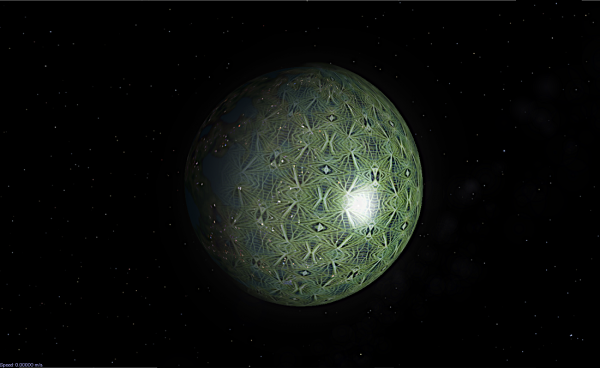BY LETTER
Canopy Plant
Science > Biology > Botany
Technology > Technology Type or Material > Gengineering
Technology > Technology Levels > High Tech / Hitech
Technology > Application > Infrastructure
Technology > Application > Megascale Engineering
Technology > Technology Type or Material > Nanotech
Technology > Application > Neogenics
Technology > Technology Type or Material > Organic/Biotech
Technology > Technology Type or Material > Gengineering
Technology > Technology Levels > High Tech / Hitech
Technology > Application > Infrastructure
Technology > Application > Megascale Engineering
Technology > Technology Type or Material > Nanotech
Technology > Application > Neogenics
Technology > Technology Type or Material > Organic/Biotech
Biological Paraterraforming | |
 Image from Steve Bowers | |
| Piav, a small world entirely enclosed in a Canopy Plant worldhouse roof | |
The Canopy Plant is a neogen terraforming plant with bionano capabilities that was developed by the Softbot Coordinator Systems as an alternative to the Yggdrasil Bush. The plant's growth follows this basic outline:
1) Hardened seedpods are dropped from planetary orbit. They may be decelerated by parachute or balloon cushion depending on the atmosphere of the target body.
2) Pods penetrate the surface or burrow down to their optimal depth.
3) Each seedpod begins to extend a root system through the ground and a solar energy collecting canopy bud to the surface.
4) The plant extends its canopy, utilizing material mined from the air and ground. It sends up to three fast growing runners that are separated from one another by approximately 120 degrees. When they reach a preset distance they set down new root systems. The canopy membrane grows out from the taproot and the edges of the runners. As it grows it is initially anchored to the ground by temporary rootlets.
5) New root systems produce their own canopy buds and send out their own runners until they begin to link up in a roughly hexagonal network according to local terrain.
6) The canopy continues to grow from the vertices and runner edges until it covers an entire hexagon. The air pressure beneath the canopy rises as atmosphere is processed, causing the canopy dome to inflate. Curtain membranes grow between each canopy and runner, sealing each hexagonal cell off from the others. Tailored biota and bionano are then introduced into the cells to further prepare the developing biome.
7) As ceiling height increases the curtain walls may be detached, creating ever-greater continuous space beneath the canopy which remains anchored to the surface by the original stems.
8) Atmospheric processing and terraforming may continue in the air outside of the canopy domes till the desired composition and pressure are achieved. Air pressure under the canopy may then be equalized with that outside, and the cell canopies rent to expose the cell interiors. The plant's biomass can then be recycled into the new environment. This can be done progressively if adjoining cells remain sealed off by the curtain walls and are kept under higher pressure.
The speed of Canopy Plant growth is dependent upon insolation and the composition of the regolith and atmosphere from which the plant draws material. Once the runner network is in place, needed feedstock may be transported through it to where it will be most useful. Sunlight can be augmented by orbital mirrors or magnifying solettas and required nutrients and volatiles may be imported if they are deficient in the native environment, unless slower growth or more limited coverage is not an issue to those in charge of the project. Under optimal conditions the area covered by canopy can double every six weeks and an Earth sized planet can be covered in as little as five years from an initial planting of 10,000 uniformly spaced seedpods.
 Image from Steve Bowers | |
| The Canopy Plant on Lancer's World covers the entire surface | |
The Canopy Plant is well suited for the terraforming of most Gaian, Arean, and early Cytherean planets, with little or no additional technological input. Some LithicGelidian worlds are also suitable but require a greater degree of intervention and maintenance.
The advantage that the Canopy Plant has over the Yggdrasil Bush is that it can cover a given area more quickly and its growth is more easily directed or altered by the supervisory team. Also, terraforming occurs progressively as more cells are covered by canopy, so that the terraformers need not wait for the entire worldhouse infrastructure to be in place. Finally, less potential biomass is bound up in the plant itself, and clearing it out when the terraforming process is nearing or at completion is far easier. On the other hand, the Yggdrasil Bush can tolerate a much greater range of initial environmental conditions, and is more adaptable and requires less outside supervision due to the greater processing power invested in each Yggdrasil trunk. Also a Yggdrasil Bush is much sturdier and more reliable if a worldhouse is the desired final outcome.
Smaller versions of the Canopy plant are used to envelop planetoids, asteroids and comets; these are generally known as Space Canopies and Greenbubbles.
Related Articles
Appears in Topics
| Botany | Gengineering | High Tech / Hitech |
| Infrastructure | Megascale Engineering | Nanotech |
| Neogenics | Organic/Biotech |
Development Notes
Text by Terrafamilia
Initially published on 13 March 2005.
page uploaded 13 March 2005, last modified 13 July 2007
Canopy Plant is derived from the "Mars Wrap" described by by Charles R. Morgan in "Terraforming with Nanotechnology" in the Journal of British Interplanetary Society, 47, no. 8, pp. 311-318 (August 1994)
Initially published on 13 March 2005.
page uploaded 13 March 2005, last modified 13 July 2007
Canopy Plant is derived from the "Mars Wrap" described by by Charles R. Morgan in "Terraforming with Nanotechnology" in the Journal of British Interplanetary Society, 47, no. 8, pp. 311-318 (August 1994)






